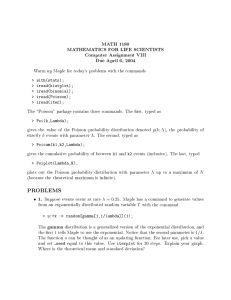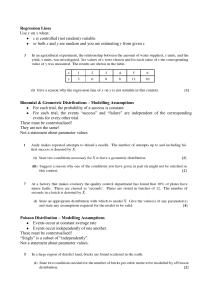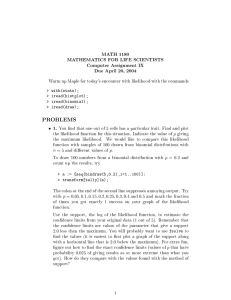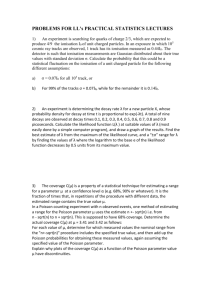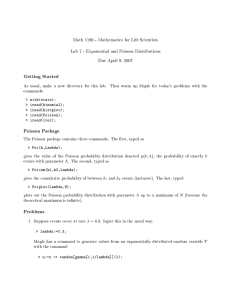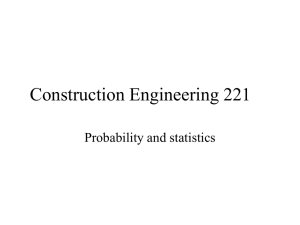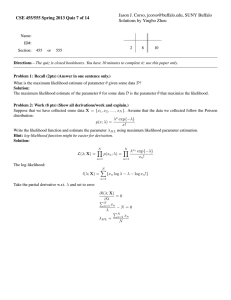Math 1180 - Mathematics for Life Scientists
advertisement
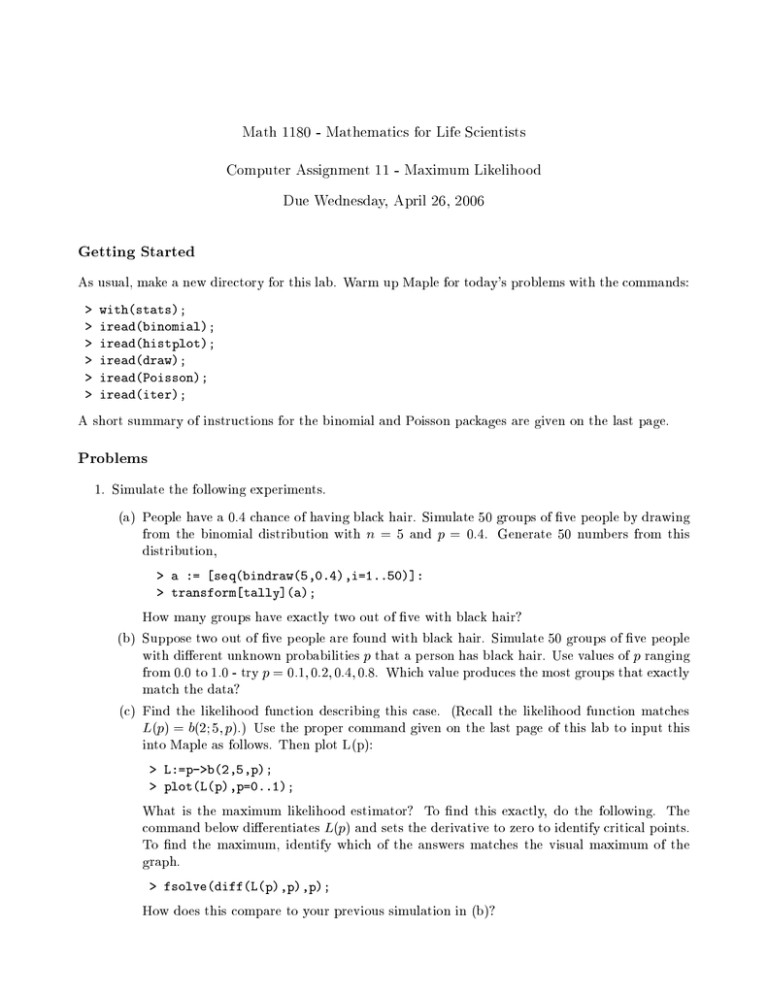
Math 1180 - Mathematics for Life Scientists Computer Assignment 11 - Maximum Likelihood Due Wednesday, April 26, 2006 Getting Started As usual, make a new directory for this lab. Warm up Maple for today's problems with the commands: > > > > > > with(stats); iread(binomial); iread(histplot); iread(draw); iread(Poisson); iread(iter); A short summary of instructions for the binomial and Poisson packages are given on the last page. Problems 1. Simulate the following experiments. (a) People have a 0.4 chance of having black hair. Simulate 50 groups of ve people by drawing from the binomial distribution with = 5 and = 0 4. Generate 50 numbers from this distribution, n p : > a := [seq(bindraw(5,0.4),i=1..50)]: > transform[tally](a); How many groups have exactly two out of ve with black hair? (b) Suppose two out of ve people are found with black hair. Simulate 50 groups of ve people with dierent unknown probabilities that a person has black hair. Use values of ranging from 0.0 to 1.0 - try = 0 1 0 2 0 4 0 8. Which value produces the most groups that exactly match the data? (c) Find the likelihood function describing this case. (Recall the likelihood function matches ( ) = (2; 5 ).) Use the proper command given on the last page of this lab to input this into Maple as follows. Then plot L(p): p p L p b : ; : ; : ; p : ;p > L:=p->b(2,5,p); > plot(L(p),p=0..1); What is the maximum likelihood estimator? To nd this exactly, do the following. The command below dierentiates ( ) and sets the derivative to zero to identify critical points. To nd the maximum, identify which of the answers matches the visual maximum of the graph. L p > fsolve(diff(L(p),p),p); How does this compare to your previous simulation in (b)? (d) Explain how the simulation in (a) diers from those done in (b) and (c). In each case, indicate what is known and what is unknown. 2. Cells are placed for one minute in an environment where they are hit by X-rays, some of which are damaging. Cells not hit by the damaging rays are healthy, those hit exactly once are damaged, and those hit more than once are dead. By measuring the states of a number of cells, we wish to infer the rate at which cells are hit by damaging rays. Let denote the unknown parameter of the Poisson distribution. Use the Poisson package to compute the probabilities 0 of no hits, 1 of one hits, and m of more than one hit in one minute as functions of . For example, dene 0 as a function in Maple using x p p x p p > p0:= x -> Poi(0,x); Dene m as follows: p > pm:=x->1-p0(x)-p1(x); After you dene the three functions above, enter the following arrays. > v:= [0,1,2]; > p:= [p0(x),p1(x),pm(x)]; (a) Suppose the true value of x is x:= 3.0. Plot the histogram using > histplot(v,p); (b) Set a random seed seed to a \random" value dredged from your subconscious. Simulate 50 cells using the draw command: > a := [seq(draw(v,p),i=1..50)]: > transform[tally](a); How many cells of each type do you get from your simulation? To keep things interesting, continue sampling until you get at least one cell of each type. (c) Compare the results for your simulation with the idealized histogram. For example, the theoretical value for type 0 is > n0 := 50*p0(x); How well do your results match? (d) Now pretend that x is your unknown. Use the method of maximum likelihood to analyze your data. Find the likelihood function of the data you obtained in part (b). It is the product of the likelihoods for each of the 50 cells. Input the likelihood function as a function of the unknown parameter into Maple using the proper command from the nal page of this lab. For instance, if you has 5 with zero hits, 10 with one, and 35 with more than one, then: L y > L:=y->Poi(0,y)^5*Poi(1,y)^10*(1-Poi(0,y)-Poi(1,y))^35; (The nal part of the above term is the probability that a cell is not hit by exactly 0 or 1 hits.) Additionally, dene as the natural log of . Again input this as a function of in Maple: S L y > S:=y->ln(L(y)); Plot ( ) over a reasonable range of . S y y The function ( ) is called the support of the unknown parameter . As we have seen in class and also in this problem, values of the likelihood function can be tiny. By taking the natural log, you can compare likelihoods of dierent values of the parameter more easily. (e) Find the maximum of ( ) by using the following command. S y y y S y > ymax:= fsolve(diff(S(y),y),y); Mark this value on your plot. (f) Find ( ) for = max above. Additionally, nd the values of ( ) for = 2, = 4, and the "true" parameter value = 3. Indicate each of them on your graph. Comment on your result. S y y y S y y y y Binomial Package The binomial package contains the following commands you may want to use today: 1. Probability Mass Function ( ) b k; n; p > b(k,n,p); This command gives the probability of obtaining exactly successes in trials each with success probability . 2. Cumulative Distribution Function ( ) k n p B k; n; p > B(k,n,p); This command gives the the probability of obtaining success probability . k or fewer successes in trials each with n p Poisson Package The Poisson package contains three commands. The rst, typed as > Poi(k,Lambda); gives the value of the Poisson probability distribution denoted ( ; ), the probability of exactly events with parameter . The second, typed as p k k > Poicum(k1,k2,Lambda); gives the cumulative probability of between k1 and k2 events (inclusive). The last, typed > Poiplot(Lambda,N); plots out the Poisson probability distribution with parameter up to a maximum of theoretical maximum is innite). N (because the
